I am going to begin participating in the NRL shoots in my area and would like to in the not to distant future also give 22lr PRS a try as well. Absolutely EVERYTHING I have read seen or heard is scopes in MILLs are used by over 90% of participants VS MOA for multiple reasons, simplicity chief among them.
I have been thinking strictly in MOA for over 30 years and would like to know if there is a methodology I can use to transition my thinking as simply and painlessly from MOA to MILLs.
As I am a complete novice when it comes to tactical scopes and have some but only minimal experience dialing for drop or wind deflection. This will also be my first endeavor into the world of tactical scopes or using the strata on the scopes reticle to make adjustments for drop and wind deflection.
My main issue is the distances to the targets in both NRL and 22lr PRS are listed in yards and if you have a scope in MILL/MILL and unless I am wrong, you will have to convert that distance into meters then figure your scope adjustments accordingly.
One other concern is I have yet to buy a scope for participating in NRL/PRS and will have to decide if it will be in MOA/MOA or MILL/MILL and need to make a choice.
If there is a good book on long range shooting that has a chapter on how a person use to MOA can transition to MILLs, please by all means someone tell me as I would gladly buy it to educate myself.
I realize there my be no other way other than to just re-learn to adjust a scope in MILLs but if anywhere on the internet would know I figured it would be here.
I have been thinking strictly in MOA for over 30 years and would like to know if there is a methodology I can use to transition my thinking as simply and painlessly from MOA to MILLs.
As I am a complete novice when it comes to tactical scopes and have some but only minimal experience dialing for drop or wind deflection. This will also be my first endeavor into the world of tactical scopes or using the strata on the scopes reticle to make adjustments for drop and wind deflection.
My main issue is the distances to the targets in both NRL and 22lr PRS are listed in yards and if you have a scope in MILL/MILL and unless I am wrong, you will have to convert that distance into meters then figure your scope adjustments accordingly.
One other concern is I have yet to buy a scope for participating in NRL/PRS and will have to decide if it will be in MOA/MOA or MILL/MILL and need to make a choice.
If there is a good book on long range shooting that has a chapter on how a person use to MOA can transition to MILLs, please by all means someone tell me as I would gladly buy it to educate myself.
I realize there my be no other way other than to just re-learn to adjust a scope in MILLs but if anywhere on the internet would know I figured it would be here.






